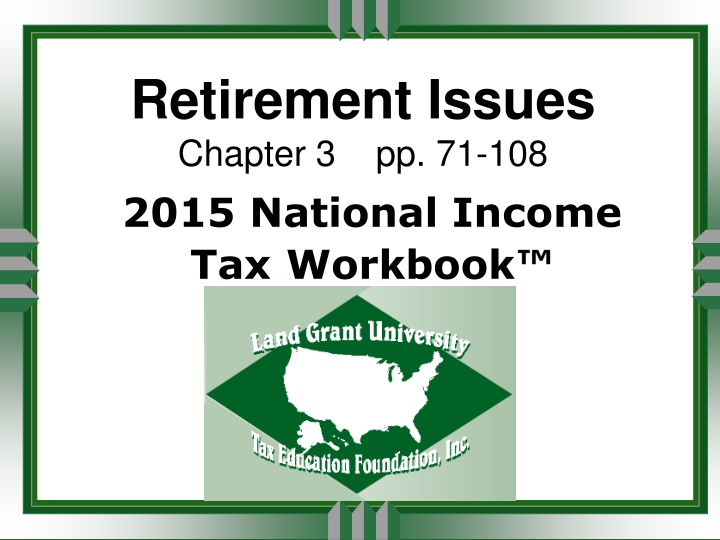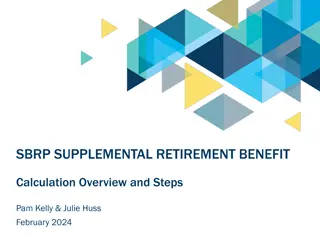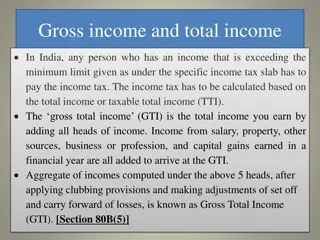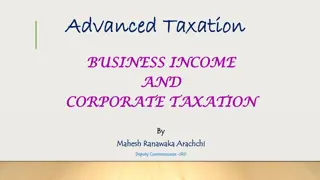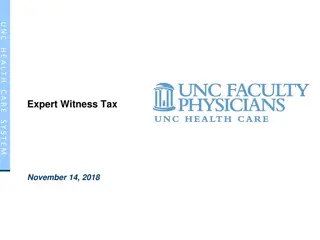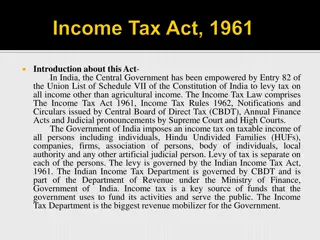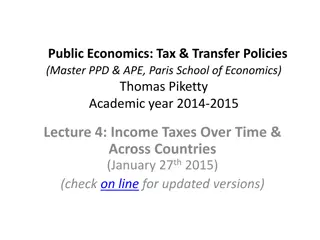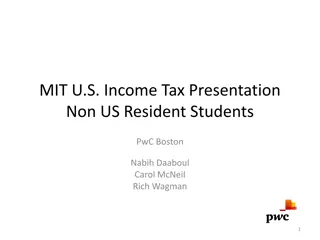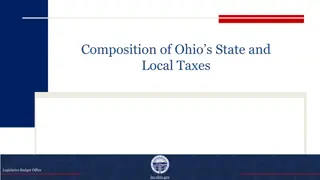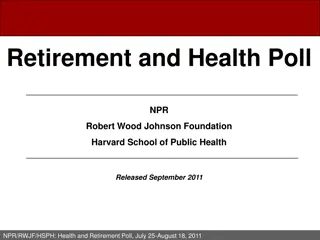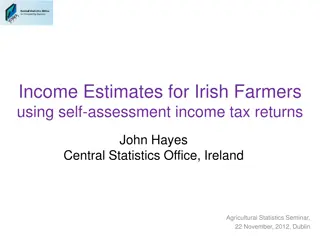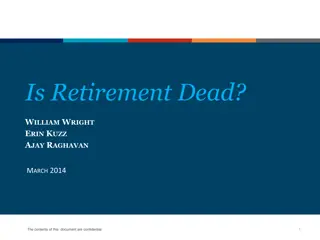Retirement Issues Chapter 3: National Income Tax Workbook
This chapter delves into various retirement planning topics such as tax treatment of annuities, reverse mortgages, net unrealized appreciation in employer securities, and more. It provides insights and checklists to ensure retirement plans are compliant and up to date.
Download Presentation

Please find below an Image/Link to download the presentation.
The content on the website is provided AS IS for your information and personal use only. It may not be sold, licensed, or shared on other websites without obtaining consent from the author.If you encounter any issues during the download, it is possible that the publisher has removed the file from their server.
You are allowed to download the files provided on this website for personal or commercial use, subject to the condition that they are used lawfully. All files are the property of their respective owners.
The content on the website is provided AS IS for your information and personal use only. It may not be sold, licensed, or shared on other websites without obtaining consent from the author.
E N D
Presentation Transcript
Retirement Issues Chapter 3 2015 National Income TaxWorkbook pp. 71-108
Retirement Issues pp. 71-108 Retirement Plan Operations Form 1099-R Tax Treatment of Nonqualified Annuities Reverse Mortgages Tax Treatment of Net Unrealized Appreciation in Employer Securities Tax Consequences of Selling a Business
Checklists for Retirement Planning p. 71-79 Planning checklists can help practitioners conduct regular reviews of retirement plan operations. Annual steps to keep SEPs, SIMPLEs, 401(k)s, and IRAs up to date and compliant are included here.
SEP pp. 71-73 Check For Changes In The Law Identify Any Related Employers Review Employee Eligibility For Participation In The SEP
SEP continued pp. 71-73 Determine If Employee Compensation Was Calculated Correctly Verify That Contributions Are Based on a Uniform Percentage Review SEP Contribution Limits
SIMPLE IRA pp. 73-75 Check for Changes in the Law Confirm That the Business Had 100 or Fewer Employees Determine If There Were Other Plans Sponsored by the Business Verify That All Eligible Employees Are Allowed to Participate in the Plan Review the Calculation of Employee Compensation
SIMPLE IRA continued pp. 73-75 Review Employer Contributions Check the Elective Deferral Deposit Dates Determine If There Are Terminated Participants Who Were Eligible to Participate Confirm That SIMPLE IRA Plan Notification Requirements Were Met
401(k) pp. 75-78 Make Certain That the Plan Document Has Been Updated Review Plan Operations for Consistency with Plan Terms Verify That the Plan Definition of Compensation Is Applied Correctly Examine Employer Matching Contributions
401(k) continued pp. 75-78 Perform the 401(k) ADP and ACP Nondiscrimination Tests Confirm That All Eligible Employees Were Give the Opportunity to Make an Elective Deferral Verify that Elective Deferrals Do Not Exceed the I.R.C. 402(g) Limit Check the Elective Deferral Deposit Dates
401(k) continued pp. 75-78 Make Sure That Participant Loans Meet Requirements Determine If Hardship Distributions Were Made Properly Assess Whether Top-Heavy Minimum Contributions Were Made Verify That Form 5500 Was Filed
Traditional and Roth IRA p. 78 Check the Maximum IRA Contribution Meet the Deadline for Making a Contribution Withdraw Any Excess Contribution Confirm That Required Minimum Distributions Were Timely Made
Required Minimum Distributions p. 79 IRA owners must calculate the RMD separately for each of their IRAs, but they can withdraw the total amount from one or more of the IRAs. RMDs from other types of qualified retirement plans, such as 401(k) plans, must be taken separately from each plan account.
Form 1099-R pp. 79-83 Anyone receiving >$10 from a retirement plan receives Form 1099-R. Generally not required if payments are tax exempt (worker s comp or VA payments). See figure 3.1 for an example Form 1099-R
General Form 1099-R Issues p. 80 It is important to very calculations and reported information on Form 1099-R Box 2a taxable amount Box 2b indicates the taxable amount cannot reasonably be calculated Box 5 amount the employer can recover tax free in current year Box 6 net unrealized appreciation in the employer securities if there was a lump sum distribution, but only the portion attributable to the employee contributions if there was not Box 8 current actuarial value of an annuity contract that is part of a lump sum distribution Box 10 amount of a distribution that is allocable to an in-plan Roth rollover (IRR)
General Form 1099-R Issues p. 80 Taxpayers may not always bring Form 1099-R to their tax preparer. To determine whether a Form 1099-R was issued, the tax preparer should consider the age of the taxpayer, whether the taxpayer received a Form 8606, Nondeductible IRAs, and whether Form 1099-R was issued in prior years.
Specific Issues Involving Form 1099-R pp. 80-83 Proving a Rollover A direct rollover is reported on Form 1099-R through a gross distribution in box 1, a zero in box 2a, and code G in box 7. Additionally, to verify the rollover, when the rollover amount is received by a new provider, a Form 5498 must be submitted. See Figure 3.3 for an example Form 5498
Specific Issues Involving Form 1099-R pp. 80-83 Charitable Contributions Qualified charitable donations from an IRA were allowed through Dec. 31st, 2014. Individuals age 70.5 or older could exclude up to $100,000 from gross income for IRA distributions paid directly to a qualified charity. Responsibility of the taxpayer, not IRA trustee, to verify the charity is qualified and the distribution meets all requirements.
Nonqualified Annuities pp. 83-91 Nonqualified annuities are purchased outside of qualified retirement plans or IRAs, and there are no restrictions on the amount of contributions to the annuity. A nonqualified annuity distribution is identified on Form 1099-R by code 7D in box 7. Distributions from a nonqualified annuity are considered net investment income and may be subject to the net investment income tax (NIIT).
Taxing Distributions p. 84 Withdrawals When an annuitant makes a withdrawal, it is taxed as gain first, then basis. Gain is ordinary income, and the basis is tax-free. See Example 3.1 Annuitization Annuitant can elect to annuitize the contract, changing the cash value into an income source. Each payment will have a taxable portion and a return of basis. See Example 3.2
Taxing Distributions p. 84 Guaranteed Withdrawals Benefits Annuitants can purchase an option to protect their investments with a guaranteed annual withdrawal percentage. If the value of the annuity is less than the original purchase price, the annuitant can still make annual withdrawals up to the original cost. Any amounts in excess of the investment are taxed as ordinary income. Inherited Nonqualified Annuities If the beneficiary is the spouse of the annuitant, he or she may be able to continue the policy without tax consequences if the death benefit is paid into the policy.
General Rule for Taxation of Nonqualified Annuities pp. 84-89 Nonqualified annuity distributions are taxed using the general rule, which requires that the part of each annuity payment that represents the net cost is in the same proportion that the investment in the contract is to the expected return.
General Rule for Taxation of Nonqualified Annuities pp. 84-89 Investment in the Contract To determine investment in the contract, the taxpayer must first calculate the net cost. The net cost is the total cost plus certain adjustments, and minus amounts that are recovered prior to the annuity starting date. The net cost is the unrecovered investment in the contract as of the annuity starting date. If the annuity starting date is after 1986, net cost is also the maximum amount that can be recovered tax-free. To determine the net cost, first calculate total cost, which is the total premiums, contributions, or other amounts paid. From the total cost, subtract any refunded amounts received by the later of the annuity starting date or the date on which the first payment was received to arrive at the net cost.
General Rule for Taxation of Nonqualified Annuities pp. 84-89 Investment in the Contract Foreign Employment If the owner worked abroad and the employer contributed to the retirement plan, an addition to the total cost may be required. Contributions are an allowable part of the total cost only if the contributions would have been excluded from gross income if paid directly as compensation. The included contributions are the following: 1. Employer contributions before 1963 2. Employer contributions after 1962 if the contributions would be excluded from gross income if paid directly to the employee (without regard to the foreign earned income exclusion) 3. Employer contributions after 1996 on behalf of person working as a foreign missionary (duly ordained, commissioned, or licensed minister of a church or a layperson) if the contributions would be excluded from gross income if paid directly to the employee
General Rule for Taxation of Nonqualified Annuities pp. 84-89 Investment in the Contract Death Benefit There used to be a death benefit exclusion for the beneficiary of a deceased employee, but that exclusion is not available if the employee died after August 20, 1996.
General Rule for Taxation of Nonqualified Annuities pp. 84-89 Investment in the Contract Refund Feature If an annuity has a refund feature, net cost is reduced by the value of the refund feature. A refund feature is present if: 1. the expected return depends upon the life of one or more people; 2. the contract requires continued payments until a stated amount is paid or a stated 3. number of payments are made, even if the annuitant dies earlier; or 4. the payments are a refund of the cost of the contract.
General Rule for Taxation of Nonqualified Annuities pp. 84-89 Investment in the Contract Actuarial Tables The actuarial tables are used if the annuitant is receiving payments for life, as opposed to payments for a fixed number of years. In general, Tables V through VIII must be used if contributions were made to the retirement plan after June 30, 1986. If contributions were made before and after June 30, 1986, an election allows separate calculations using the appropriate tables for each time period. To make the election, the taxpayer has to attach the following statement to the income tax return for the first year in which a payment is received: I elect to apply the provisions of paragraph (d) of section 1.72-6 of the Income Tax Regulations. The statement must also include the taxpayer s name, address, social security number, and the amount of the pre-July 1986 investment.
General Rule for Taxation of Nonqualified Annuities Investment in the Contract Formula For Refund Value The worksheet for calculating the value of a refund feature and the investment in the contract is illustrated in Examples 3.3 and 3.4. pp. 84-89
General Rule for Taxation of Nonqualified Annuities Expected Return The expected return from an annuity contract depends upon the annuitant s age at the birthday nearest to the annuity starting date, and the type of annuity. pp. 84-89
General Rule for Taxation of Nonqualified Annuities Expected Return Fixed Period Annuity The life expectancy of the annuitant is not a factor, so the actuarial tables are not required. The expected return is the payment amount times the guaranteed number of payments. pp. 84-89
General Rule for Taxation of Nonqualified Annuities Expected Return Single Life Annuity If the contributions were all made to a single life annuity after June 30, 1986, use Table V (otherwise use Table I). The expected return is the annual payment times the multiple shown in Table V for the appropriate age. pp. 84-89
General Rule for Taxation of Nonqualified Annuities Expected Return Annuity for the Shorter of Life or a Specified Period An annuity for the shorter of life or a specified period is also known as a temporary life annuity. The annuitant receives a lifetime annuity or payments for a specific number of years, whichever period is shorter. Table VIII (or Table IV) is used to calculate the expected return. pp. 84-89
General Rule for Taxation of Nonqualified Annuities pp. 84-89 Expected Return Joint and Survivorship Annuities If the first annuitant and the survivor receive the same amount, the expected return is based on their combined life expectancies. The expected return is the annual payment multiplied by the multiple in Table VI (or Table II). The ages of the first annuitant and the survivor are both required to determine the multiple. The multiple has to be adjusted if the payments are made quarterly, semiannually, or annually instead of monthly.
General Rule for Taxation of Nonqualified Annuities pp. 84-89 Computation of the Taxable Part of an Annuity 1. 2. 3. Figure the adjusted investment in the contract. Figure the expected return. Divide Step 1 by Step 2 and round to three decimal places. This is the exclusion percentage. Multiply the exclusion percentage by the first regular periodic payment. This is the tax-free portion of each payment. The amount does not change even if the payments change. Multiply the tax-free part of each payment (Step 4) by the number of payments received for the year. This is the tax-free part of the total payment for the year. Subtract the tax-free part from the total payment received for the year; the remaining amount is taxable for the year. 4. 5. 6.
General Rule for Taxation of Nonqualified Annuities pp. 84-89 Exclusion Limits If the annuity starting date is after 1986, the amount of annuity income that can be excluded is limited to the net cost of the annuity. The refund feature is not a part of the net cost calculation. If the cost is not recovered before the death of the annuitant (or last survivor), it is allowed as a miscellaneous itemized deduction on the final return of the decedent, and is not subject to the 2% of adjusted gross income floor. Annuities with starting dates prior to 1987 can continue to take the monthly exclusion for as long as the annuity payments are received by the annuitant or by a survivor. This may result in the total exclusion exceeding the investment in the contract.
General Rule for Taxation of Nonqualified Annuities pp. 84-89 Variable Annuities The tax-free portion of a variable annuity is calculated by dividing the investment in the contract (as adjusted for a refund feature) by the total number of payments expected under the contract. If the annuity is for a definite period, the number of payments equals the number of payments made each year multiplied by the guaranteed number of years. Calculation of the tax-free portion of a life annuity requires a multiple from the appropriate actuarial table.
General Rule for Taxation of Nonqualified Annuities pp. 84-89 Other Plans Required to Use the General Rule Most qualified plans can use the Simplified Method, which is discussed in Publication 575, Pension and Annuity Income. A qualified plan is required to use the General Rule if: 1. the annuity starting date is before November 19, 1996 (and after July 1, 1986), and the annuitant did not qualify to use the Simplified Method or did not choose to use it; or 2. the annuity starting date is after November 18, 1996, and as of that date the annuitant is age 75 or over and the annuity payments are guaranteed for at least 5 years.
Nonqualified Annuity Special Tax Issues pp. 89-91 Early Withdrawal Penalty There is a 10% penalty for distributions taken from a nonqualified annuity before age 59 , subject to exceptions: 1. Substantially equal periodic payments over the life expectancy of the owner/plan participant. 2. Total and permanent disability. 3. Death of the owner/plan participant. There are additional exemptions specifically for nonqualified annuities. See Examples 3.12-3.14.
Nonqualified Annuity Special Tax Issues pp. 89-91 Section 1035 Exchange It is possible to exchange an annuity for a different annuity without any tax consequences. In order to qualify as a tax- free exchange, the annuity exchange must be handled completely by the companies involved. The annuitant on the new contract must be exactly the same as the annuitant on the old contract.
Reverse Mortgages pp. 91-94 A reverse mortgage allows seniors the opportunity to remain in their homes while receiving the built-up equity as cash. Repayment of the loan is required in the following circumstances: If the owner sells the house If the owner dies If the owner moves out for a period of 12 months without selling the house
Types of Reverse Mortgages pp. 91-92 Single Purpose Least expensive, but not available everywhere. Offered by state/local government agencies or nonprofits. Lender specifies how loan proceeds can be used. Private Loans Backed by private companies offering the loan. Borrowers with higher-valued homes may be able to borrow more money with a private loan.
Types of Reverse Mortgages pp. 91-92 Federally Insured The Home Equity Conversion Mortgage (HECM) is backed by the US Department of Housing and Urban Development (HUD) and can be used for any purpose. The amount the borrower can receive is limited to the least of: 1. The appraised value, 2. The $625,000 HECM FHA mortgage limit, 3. The purchase price, if the HECM is a purchase loan.
Financial Considerations p. 93 It is expensive to take out a reverse mortgage due to origination feeds, closing costs, servicing fees, and possible mortgage insurance premiums. Interest on the loan balance will increase the payback requirement, which is not typically on installment. Interest accrues each month, but there is no deductions for the interest until the loan is paid off.
Financial Considerations p. 93 Borrowers are still responsible for the maintenance of the property, and lenders may require set-aside amounts for upkeep which will reduce the amount paid to borrowers. Most reverse mortgages contain a nonrecourse clause, which means that the owner or the owner s estate cannot owe more than the value of the home when the loan becomes due. If the heirs want to pay off the loan and keep the house, their maximum payment is the appraised value of the home.
Questions and Answers pp. 93-94 Question #1 Appropriateness of reverse mortgages to circumstances. Question #2 Reverse mortgages cannot be assumed. Question #3 Reverse mortgages are nonrecourse. Question #4 Cancelling a reverse mortgage.
Questions and Answers pp. 93-94 Question #5 Qualifying for a reverse mortgage with an existing mortgage Question #6 Reverse mortgages vs. home equity loans. Question #7 Reverse mortgages following loan holder s death.
Net Unrealized Appreciation pp. 94-100 Net unrealized appreciation (NUA) is the net increase in the value of employer securities while they were held in a retirement plan trust. The types of employer securities that are included are stocks, bonds, registered debentures, and debentures with interest coupons attached.
Basic Tax Rules pp. 94-95 NUA received as a lump sum distribution is taxed as follows: Full value of the distribution is ordinary income. Cost basis of the security in the hands of the plan owner is the FMV of the security on the date of the distribution. Capital gains rules apply when the security is sold.
Special Tax Treatment p. 95 Taxpayers can defer tax on the NUA in lump sum distributions. When the employer securities are sold or exchanged, gain is long-term up to the amount of NUA that is not included in basis. See Examples 3.17 and 3.18.
Transfer Options pp. 96-97 When an owner decides to take company stock and/or the cash value out of a 401(k), the owner may consider a transfer of the stock to an IRA, or a transfer of the stock to a taxable brokerage account.
Transfer Options pp. 96-97 Transfer to an IRA A transfer to an IRA changes the tax rates from capital gains to ordinary income. If there is a substantial amount of NUA, that could have a negative tax effect. If the owner intends to hold the stock for a long period before selling it, it will be advantageous to keep the stock in an IRA tax-deferred account. If the owner is not yet age 59 , a transfer to an IRA will avoid the early withdrawal penalty.
